[解决方案] 如何使用 Graphviz 进行画图
Graphviz
Graphviz 是一个自动排版的作图软件,可以生成 png pdf 等格式。
dot 语言
Graphviz 构建组件为 图,节点,边,用属性对其进行描述。
以下是定义DOT语言的抽象语法,约束的规则如下:
- 元素的终止以 粗体 显示
- 文字字符用单引号 '' 引起来
- 圆括号 () 的内容为必选项
- 方括号 [] 为可选项目
- 竖杠 | 为择一选择
声明 | 结构
- | -
graph | [ strict ] (graph | digraph) [ ID ] '{' stmt_list '}'
stmt_list | [ stmt [ ';' ] stmt_list ]
stmt | node_stmt | edge_stmt | attr_stmt | ID '=' ID | subgraph
attr_stmt | (graph | node | edge) attr_list
attr_list | '[' [ a_list ] ']' [ attr_list ]
a_list | ID '=' ID [ (';' | ',') ] [ a_list ]
edge_stmt | (node_id | subgraph) edgeRHS [ attr_list ]
edgeRHS | edgeop (node_id | subgraph) [ edgeRHS ]
node_stmt | node_id [ attr_list ]
node_id | ID [ port ]
port | ':' ID [ ':' compass_pt ] | ':' compass_pt
subgraph | [ subgraph [ ID ] ] '{' stmt_list '}'
compass_pt | (n | ne | e | se | s | sw | w | nw | c | _)
ID 其实就是一个字符串,为该组件的名称或者属性的名称,命名规则如下:
- 所有的字母
[a-zA-Z\200-\377]下划线,数字[0-9],数字不能出现在起始位置 - 纯数字 $[-]?(.[0-9]+ | [0-9]^+(.[0-9]*)6? $
- 所有用双引号引用的字符串
"..." - HTML 格式的字符串
<>
dot 语法的关键字
- strict, 严格的图限定,禁止创建多个相同的边
- graph, 无向图. 在图的创建时必须声明为有向图还是无向图
- digraph, 有向图
- node, 节点
- edge, 边
- subgraph, 子图
通过 dot 的抽象语法可以看到
- 整个 graph 必须使用 graph 或 digraph {} 进行限定说明图的属性
- 图里面的声明列表可以为空,也可以为多个,每个声明后的 ; 为可选项
- 声明有几种类型
- 节点 node
- 边 edge
- 子图 subgraph
- 属性列表
- ID = ID, 这个类型暂时还没有看到有什么作用
- 属性列表
- 必须使用中括号 [ ] 将列表项括起来
- 列表项为可选
- 属性列表项
- 以 key = value 的形式存在,列表项可选择 ',' 和 ';' 结尾
- 可存在多个列表项
- 边的声明
- 首端为 节点标识符或者子图,
- 右部分由边连接节点标识符或者子图构成,右部分可以存在多个
- 尾部可选属性列表
- 节点的声明
示例 节点的用法 node0 [label = "<postid1> string|<postid2> string|<postid3> string3", height=.5]` node0:head[color=lightblue] // 设置该部分的颜色- 首部为节点标识符 节点部分(post) 方向 组成,其中后两项为可选项。
- 后半部分为可选的属性列表
方向 | 说明
- | -
n | north 北
ne | north east 东北
e | east 东
se | south east 东南
s | south 南
sw | south west 西南
w | west 西
nw | north west 西北
c | center 中部
_ | 任意
一个方向的示例
digraph action {
node [shape = record,height=.1];
node0 [label = "<head> head|<body> body|<foot> foot", height=.5]
node2 [shape = box label="mind"]
node0:head:n -> node2:n [label = "n"]
node0:head:ne -> node2:ne [label = "ne"]
node0:head:e -> node2:e [label = "e"]
node0:head:se -> node2:se [label = "se"]
node0:head:s -> node2:s [label = "s"]
node0:head:sw -> node2:sw [label = "sw"]
node0:head:w -> node2:w [label = "w"]
node0:head:nw -> node2:nw [label = "nw"]
node0:head:c -> node2:c [label = "c"]
node0:head:_ -> node2:_ [label = "_"]
node0:body[style=filled color=lightblue]
}
效果如下 图-1
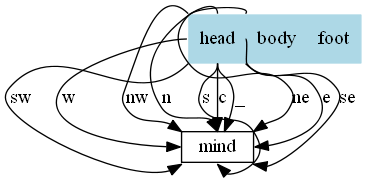
绘制属性
一个图中有非常多的 node 和 edge,如果每次都需要声明一个节点的属性会非常麻烦,有一个简单的方式为声明一个公共的属性如
digraph action {
rankdir = LR // 设置方向
node [shape=box color=blue]
edge [color=red]
node1 // 默认节点属性
node2 [color=lightblue] // 属于该节点的颜色属性
node1 -> node2 // 默认边属性
node2 -> node1 [color=green] // 属于该变的属性
}
在声明位置之后的节点都有一个 默认 的形状和颜色属性。

节点里面还可以嵌套多个结构,如
digraph D {
node [shape =record, charset = "UTF-8" fontname = "Microsoft Yahei", fontsize = 14]
china [label = " 中国 | { 浙江 | { 杭州 | { 西湖区 | { 西湖 | { 苏堤 | 断桥 } | 西溪湿地} | 余杭区 } | 宁波}}"]
ngx_pool_t [
color = "cornflowerblue"
label = "ngx_pool_t | {
{d | {
*last |
*end |
*next |
failed
}}|
*max |
*current |
*chain |
*cleanup |
*log
}"
]
}

全部的属性见graphviz官网,这里列举部分常用的属性
- charset 编码,一般设置 UTF-8
- fontname 字体名称,这个在中文的情况需要设置,否则导出图片的时候会乱码,一般设置微软雅黑("Microsoft YaHei"), linux 下也是同样设置系统带的字体就好,其他字体设置见fontpath 属性
- fontcolor 字体颜色
- fontsize 字体大小,用于文本内容
- fillcolor 用于填充节点或者集群(cluster)的背景颜色。
- size 图形的最大宽度和高度
- label 图形上的文本标记
- margin 设置图形的边距
- pad 指定将绘制区域扩展到绘制图形所需的最小区域的长度(以英寸为单位)
- style 设置图形组件的样式信息。 对于聚类子图或者节点,如果style = "filled",则填充聚类框的背景
![]()
- rankdir 设置图形布局的排列方向 (全局只有一个生效). "TB", "LR", "BT", "RL", 分别对应于从上到下,从左到右,从下到上和从右到左绘制的有向图。
- ranksep 以英寸为单位提供所需的排列间隔
- ratio 设置生成图片的纵横比
节点(node)
节点的默认属性为 shape = ellipse, width = .75, height = 0.5 并且用节点标识符作为节点的显示文字。
如图一中所示,声明两个节点 node0 和 node2,node0 或 node2 就表示这个节点的节点标识符,后面紧跟的是该节点的属性列表;另一种用法为 节点标识符:节点部分:方向[属性列表] node0:body[style=filled color=lightblue], 这个为单一节点声明的方式。
节点中最基本的属性为:
- shape 形状,全部形状见graphviz官网,一些常用的图形有
![]()
- width height, 图形的宽度和高度,如果设置了 fixedsize 为 true,则宽和高为最终的长度
- fixedsize, 如果为false,节点的大小由其文本内容所需要的最小值决定
- rank 子图中节点上的排列等级约束. 最小等级是最顶部或最左侧,最大等级是最底部或最右侧。
- same. 所有节点都位于同一等级
- min. 所有节点都位于最小等级上
- source. 所有节点都位于最小等级上,并且最小等级上的唯一节点属于某个等级 source 或 min 的子图.
- max sink. 和上类似
边 (edge)
有向图中的的边用 -> 表示,无向图用 -- 表示。
可以同时连接多个节点或者子图,但是只能有一个属性列表,如下
digraph {
rankdir = LR
A -> B -> c[color=green]
}

一些关于边的属性如下:
digraph {
rankdir = LR
splines = ortho
A -> B -> C -> D -> F [color = green]
E -> F -> B -> D [color = blue]
B -> E -> H[color = red]
}
-
len 首选边的长度
-
weight 边的权重, 权重越大越接近边的长度
-
lhead 逻辑边缘的头部(箭头那个位置),compound 设置为 true 时,边被裁减到子图的边界处
-
ltail 类似 lhead
-
headlabel 边上靠近箭头部分的标签
-
taillabel 边上靠近尾部部分的标签
设置 A->B->C->D->F的权重最大,修改绿色的分支的权重为 100,使其变成主要逻辑分支。
![]()
-
splines 控制如何以及是否表示边缘。其值如下
- none 或者 "", 无边
![]()
- true 或者 spline, 样条线(无规则,可为直或者曲线)
![]()
- false 或者 line, 直线段
![]()
- polyline, 折线
![]()
- curved, 曲弧线,两条?
![]()
- ortho, 正直的线(横竖)
![]()
- none 或者 "", 无边
-
dir 设置绘制箭头的边缘类型
![]()
子图
subgraph 必须配合 cluster 一起使用,用法为 subgraph cluster* {}
需要设置 compound 为 true,则在群集之间留出边缘,子图的边界关系在 边 的定义中有给出,这里直接给个示例。
digraph G {
compound = true // 允许子图间存在边
ranksep = 1
node [shape = record]
subgraph cluster_hardware {
label = "hardware"
color = lightblue
CPU Memory
}
subgraph cluster_kernel {
label = "kernel"
color = green
Init IPC
}
subgraph cluster_libc {
label = "libc"
color = yellow
glibc
}
CPU -> Init [lhead = cluster_kernel ltail = cluster_hardware]
IPC -> glibc [lhead = cluster_libc ltail = cluster_kernel]
}
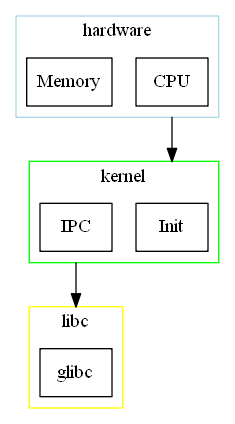
示例
TCP IP 状态流程图
展示了两个版本,怎么把这些图形节点稍微规范的显示出来
digraph {
compound=true
fontsize=10
margin="0,0"
ranksep = .75
nodesep = .65
node [shape=Mrecord fontname="Inconsolata, Consolas", fontsize=12, penwidth=0.5]
edge [fontname="Inconsolata, Consolas", fontsize=10, arrowhead=normal]
"TCP/IP State Transition" [shape = "plaintext", fontsize = 16]
// now start server state transition
"CLOSED" -> "LISTEN" [style = blod, label = "应用:被动打开\n发送:<无>"];
"LISTEN" -> "SENT_REVD" [style = blod, label = "接收:SYN\n发送:SYN,ACK"]
"SENT_REVD" -> "ESTABLISHED" [style = blod, label = "接收:ACK\n发送:<无>", weight = 20]
"ESTABLISHED" -> "CLOSE_WAIT" [style = blod, label = "接收:FIN\n发送:ACK", weight = 20]
subgraph cluster_passive_close {
style = dotted
margin = 10
passive_close [shape = plaintext, label = "被动关闭", fontsize = 14]
"CLOSE_WAIT" -> "LAST_ACK" [style = blod, label = "应用:关闭\n发送:FIN", weight = 10]
}
"LAST_ACK" -> "CLOSED" [style = blod, label = "接收:ACK\n发送:<无>"]
// now start client state transition
"CLOSED" -> "SYN_SENT" [style = dashed, label = "应用:主动打开\n发送:SYN"];
"SYN_SENT" -> "ESTABLISHED" [style = dashed, label = "接收:SYN,ACK\n发送:ACK", weight = 25]
"SYN_SENT" -> "SENT_REVD" [style = dotted, label = "接收:SYN\n发送:SYN,ACK\n同时打开"]
"ESTABLISHED" -> "FIN_WAIT_1" [style = dashed, label = "应用:关闭\n发送:FIN", weight = 20]
subgraph cluster_active_close {
style = dotted
margin = 10
active_open [shape = plaintext, label = "主动关闭", fontsize = 14]
"FIN_WAIT_1" -> "FIN_WAIT_2" [style = dashed, label = "接收:ACK\n发送:<无>"]
"FIN_WAIT_2" -> "TIME_WAIT" [style = dashed, label = "接收:FIN\n发送:ACK"]
"FIN_WAIT_1" -> "CLOSING" [style = dotted, label = "接收:ACK\n发送:<无>"]
"FIN_WAIT_1" -> "TIME_WAIT" [style = dotted, label = "接收:SYN,ACK\n发送:ACK"]
"CLOSING" -> "TIME_WAIT" [style = dotted]
}
"TIME_WAIT" -> "CLOSED" [style = dashed, label = "2MSL超时"]
}
这是一个很挫的版本,排版乱飞了。
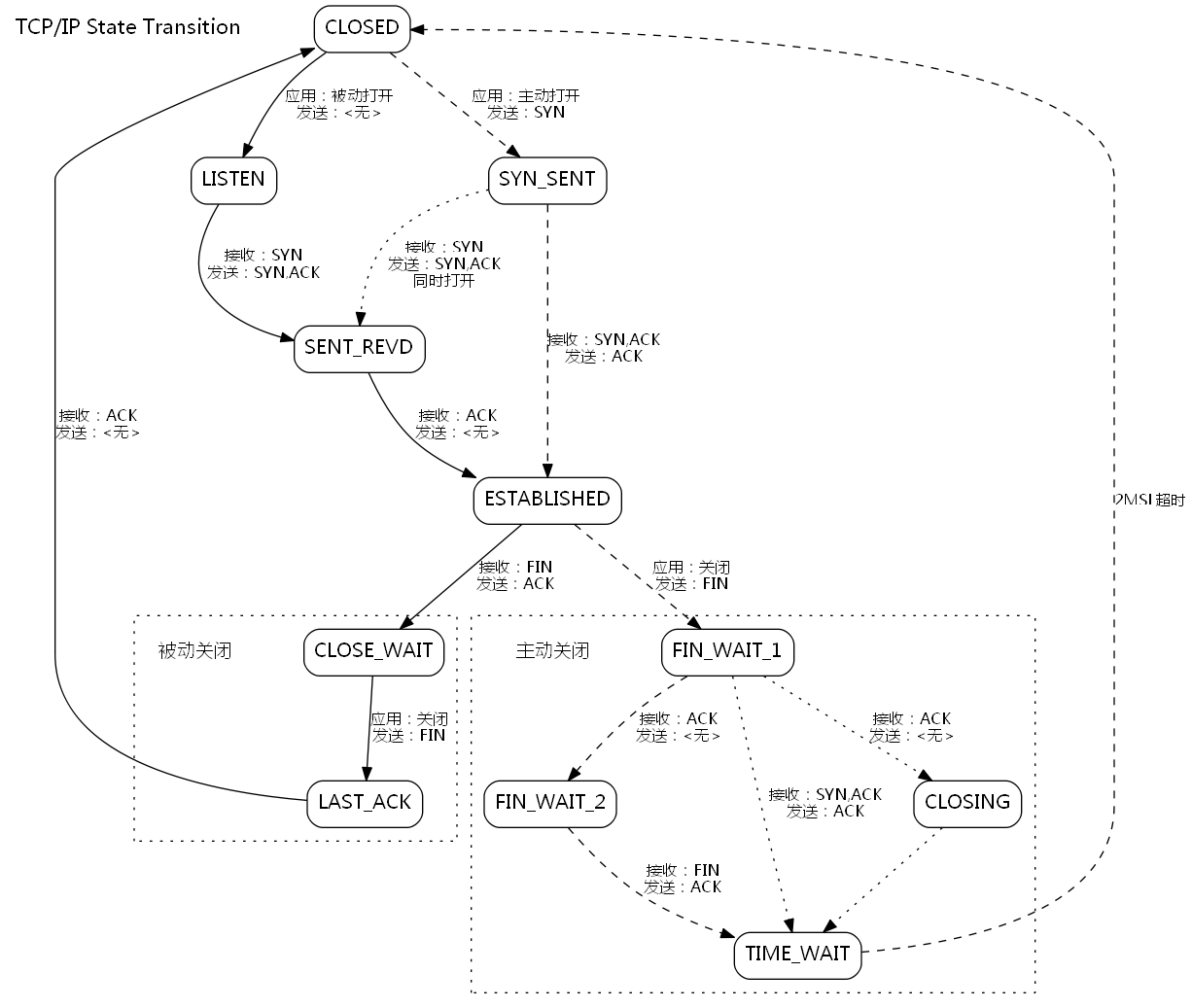
digraph rankdot {
compound=true
margin="0,0"
ranksep = .75
nodesep = 1
pad = .5
//splines = ortho
node [shape=Mrecord, charset = "UTF-8" fontname="Microsoft YaHei", fontsize=14]
edge [charset = "UTF-8" fontname="Microsoft YaHei", fontsize=11, arrowhead = normal]
CLOSED -> LISTEN [style = dashed, label = "应用:被动打开\n发送:<无>", weight = 100];
"TCP/IP State Transition" [shape = "plaintext", fontsize = 16]
{
rank = same
SYN_RCVD SYN_SENT
point_1 [shape = point, width = 0]
SYN_SENT -> point_1 [style = dotted, label = "应用关闭或者超时"]
// SYN_SENT -> SYN_RCVD 这个一行代码和上一行冲突了,syn_sent 会在syn_rcvd右边
SYN_RCVD -> SYN_SENT [style = dotted, dir = back, headlabel = "接收:SYN\n发送:SYN,ACK\n同时打开"]
}
LISTEN -> SYN_RCVD [style = dashed, headlabel = "接收:SYN\n发送:SYN,ACK"]
SYN_RCVD -> LISTEN [style = dotted, headlabel = "接收:RST"]
CLOSED:es -> SYN_SENT [style = blod, label = "应用:主动打开\n发送:SYN"]
{
rank = same
ESTABLISHED CLOSE_WAIT
ESTABLISHED -> CLOSE_WAIT [style = dashed, label = "接收:SYN,ACK\n发送:ACK"]
}
SYN_RCVD -> ESTABLISHED [style = dashed, label = "接收:ACK\n发送:<无>", weight = 9]
SYN_SENT -> ESTABLISHED [style = blod, label = "接收:SYN,ACK\n发送:ACK", weight = 10]
{
rank = same
FIN_WAIT_1
CLOSING
LAST_ACK
point_2 [shape = point, width = 0]
FIN_WAIT_1 -> CLOSING [style = dotted, label = "接收:FIN\n发送:ACK"]
LAST_ACK -> point_2 [style = dashed, label = "接收:ACK\n发送:<无>"]
}
CLOSE_WAIT -> LAST_ACK [style = dashed, label = "应用:关闭\n发送:FIN", weight = 10]
{
rank = same
FIN_WAIT_2 TIME_WAIT
point_3 [shape = point, width = 0]
TIME_WAIT -> point_3 [style = blod, label = "2MSL超时"]
}
ESTABLISHED -> FIN_WAIT_1 [style = blod, label = "应用:关闭\n发送:FIN"]
FIN_WAIT_1 -> FIN_WAIT_2 [style = blod, headlabel = "接收:ACK\n发送:<无>", weight = 15]
FIN_WAIT_2 -> TIME_WAIT [style = blod, label = "接收:FIN\n发送:ACK", weight = 10]
CLOSING -> TIME_WAIT [style = dotted, label = "接收:ACK\n发送:<无>", weight = 15]
FIN_WAIT_1 -> TIME_WAIT [style = dotted, label = "接收:ACK\n发送:<无>"]
point_3 -> point_2 [arrowhead = none, style = dotted, weight = 10]
point_2 -> point_1 [arrowhead = none, style = dotted]
point_1 -> CLOSED [style = dotted]
}
这个版本看起来有内味了,最最最的主要的原因就是我使用 rank = same 属性,将一些图形固定在 同一行,一些需要横竖的直线的地方使用 weight 来调整权重,达到横竖的直接的效果,很多地方都是微调的结果。有一个很差的地方是 使用了rank限制若干图形后,就不能使用 subgraph 属性了,这样就不能在若干不同部分的节点周边画线(对比关闭的区域)了。

epoll 相关数据结构及关系
digraph rankdot {
compound=true
margin="0,0"
ranksep = .75
nodesep = 1
pad = .5
rankdir = LR
node [shape=record, charset = "UTF-8" fontname="Microsoft YaHei", fontsize=14]
edge [style = dashed, charset = "UTF-8" fontname="Microsoft YaHei", fontsize=11]
epoll [shape = plaintext, label = "epoll 相关结构及部分关系"]
eventpoll [
color = cornflowerblue,
label = "<eventpoll> struct \n eventpoll |
<lock> spinlock_t lock; |
<mutex> struct mutex mtx; |
<wq> wait_queue_head_t wq; |
<poll_wait> wait_queue_head_t poll_wait; |
<rdllist> struct list_head rdllist; |
<ovflist> struct epitem *ovflist; |
<rbr> struct rb_root_cached rbr; |
<ws> struct wakeup_source *ws; |
<user> struct user_struct *user; |
<file> struct file *file; |
<visited> int visited; |
<visited_list_link> struct list_head visited_list_link;"
]
epitem [
color = sienna,
label = "<epitem> struct \n epitem |
<rb>struct rb_node rbn;\nstruct rcu_head rcu; |
<rdllink> struct list_head rdllink; |
<next> struct epitem *next; |
<ffd> struct epoll_filefd ffd; |
<nwait> int nwait; |
<pwqlist> struct list_head pwqlist; |
<ep> struct eventpoll *ep; |
<fllink> struct list_head fllink; |
<ws> struct wakeup_source __rcu *ws; |
<event> struct epoll_event event;"
]
epitem2 [
color = sienna,
label = "<epitem> struct \n epitem |
<rb>struct rb_node rbn;\nstruct rcu_head rcu; |
<rdllink> struct list_head rdllink; |
<next> struct epitem *next; |
<ep> struct eventpoll *ep; |
··· |
··· "
]
eppoll_entry [
color = darkviolet,
label = "<entry> struct \n eppoll_entry |
<llink> struct list_head llink; |
<base> struct epitem *base; |
<wait> wait_queue_entry_t wait; |
<whead> wait_queue_head_t *whead;"
]
epitem:ep -> eventpoll:se [color = sienna]
epitem2:ep -> eventpoll:se [color = sienna]
eventpoll:ovflist -> epitem:next -> epitem2:next [color = cornflowerblue]
eventpoll:rdllist -> epitem:rdllink -> epitem2:rdllink [dir = both]
eppoll_entry:llink -> epitem:pwqlist [color = darkviolet]
eppoll_entry:base -> epitem:nw [color = darkviolet]
}
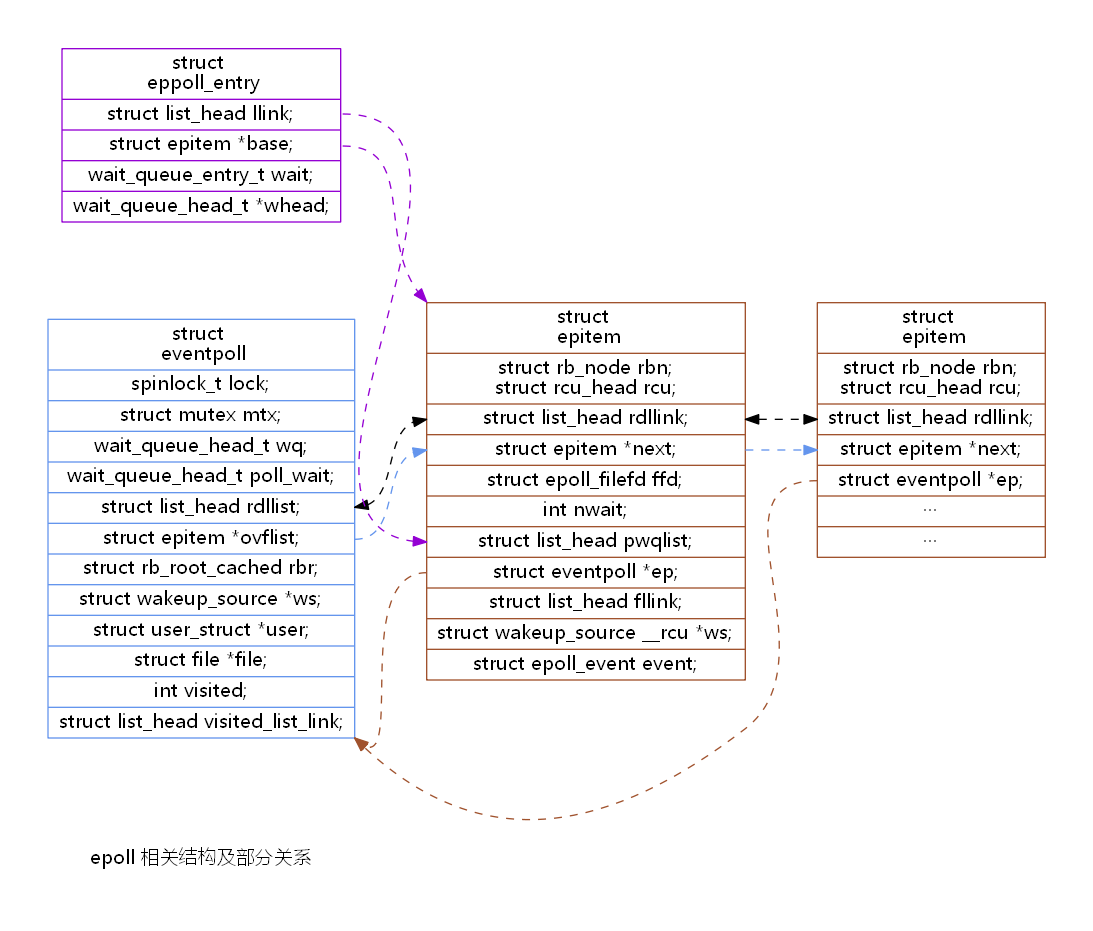
遗留问题
- 在以上TCP/IP 状态变迁图中,尝试增加主动关闭方的区域边框
- 尝试增加 TCP/IP 的时序图
使用 VSCode 进行预览生成
- 在官网下载graphviz安装包
- 安装 vscode 插件
Graphviz Preview - 在 settings.json 中添加
"graphvizPreview.dotPath": "graphviz_path\graphviz-2.38\\release\\bin\\dot.exe", graphviz_path 为所在路径,这些修改一下既可 - 新建一个 dot 文件,右上角就会有预览生成的按钮了
2020/12/05 更新,用了一圈发现并没有那么好用,自动排版是优势,但有的时候也是劣势,需要固定位置的作图时还是手动控制比较好一些,ProcessOn 用了几次觉得很不错,推荐!
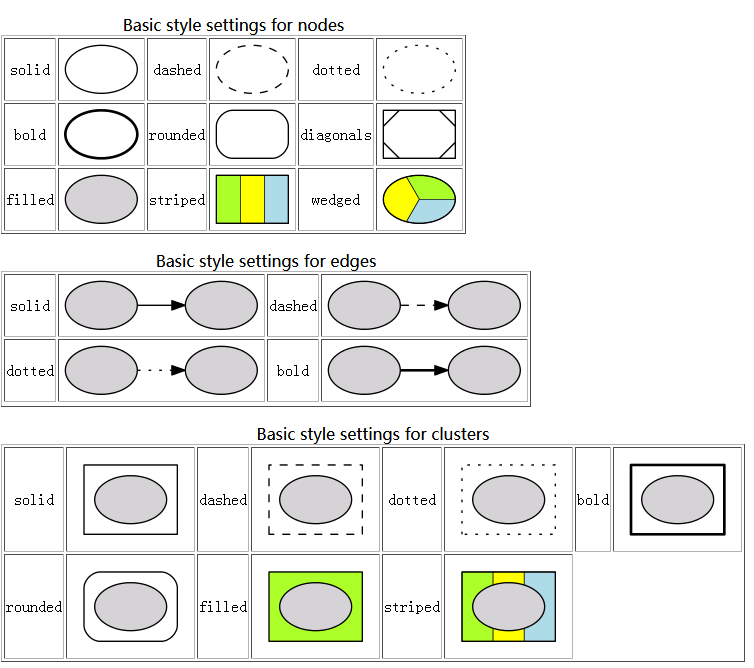

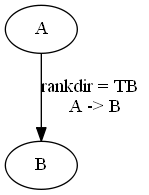



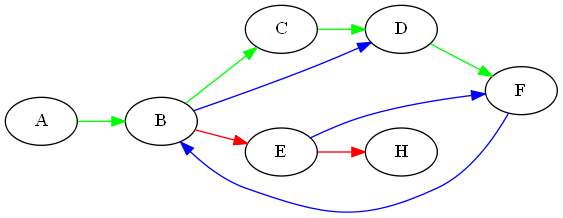

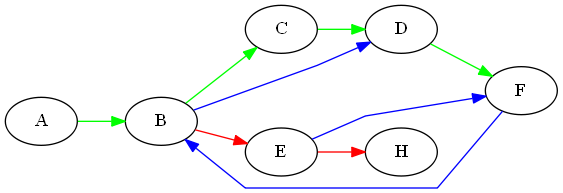


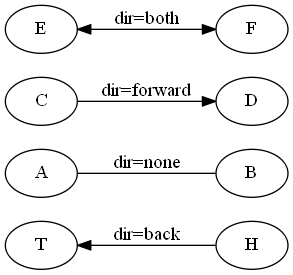

 浙公网安备 33010602011771号
浙公网安备 33010602011771号